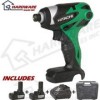Hitachi WH10DL Instruction Manual - Page 13
angle to that screw can damage the head of - manual
 |
UPC - 717709012974
View all Hitachi WH10DL manuals
Add to My Manuals
Save this manual to your list of manuals |
Page 13 highlights
Trigger switch Selector button English 8. Using the light Pull the trigger switch to light up the light. The light keeps on lighting while the trigger switch is being pulled. The light goes out after releasing the trigger switch. (Fig. 7) R marks Fig. 6 L marks 5. Switch operation ⅜ When the trigger switch is depressed, the tool rotates. When the trigger is released, the tool stops. ⅜ The rotational speed can be controlled by varying the amount that the trigger switch is pulled. Speed is low when the trigger switch is pulled slightly and increases as the trigger switch is pulled more. ⅜ When releasing the trigger of the switch, the brake will be applied for immediate stopping. NOTE: ⅜ A buzzing noise is produced when the motor is about to rotate. This is only a noise, not a machine failure. 6. Tightening and loosening screws Install the bit that matches the screw, line up the bit in the grooves of the head of the screw, then tighten it. Push the impact driver just enough to keep the bit fitting the head of the screw. Light Trigger switch Fig. 7 CAUTION: Do not look directly into the light. Such actions could result in eye injury. 9. Battery level warning lamp The battery level can be checked by pulling the trigger switch while the power tool is in a no-load state. The battery level warning lamp lights when the battery power is very low. If this happens, charge the battery. (Fig. 8) Battery level warning lamp CAUTION: ● Applying the impact driver for too long tightens the screw too much and can break it. ● Tightening a screw with the impact driver at an angle to that screw can damage the head of the screw and the proper force will not be transmitted to the screw. Tighten with this impact driver lined up straight with the screw. 7. Tightening and loosening bolts A hex. socket matching the bolt or nut must first be selected. Then mount the socket on the anvil, and grip the nut to be tightened with the hex. socket. Holding the wrench in line with the bolt, press the power switch to impact the nut for several seconds. If the nut is only loosely fitted to the bolt, the bolt may turn with the nut, therefore mistaking proper tightening. In this case, stop impact on the nut and hold the bolt head with a wrench before restarting impact, or manually tighten the bolt and nut to prevent them slipping. Fig. 8 NOTE: ⅜ The level at which the battery level warning lamp lights may vary due to the ambient temperature, characteristics of the battery, etc. and is intended only as a guide. ⅜ The battery level warning lamp may light when the power tool is overloaded. This does not mean that the battery power is very low. Be sure to check the battery level while the tool is in a no-load state. 13















